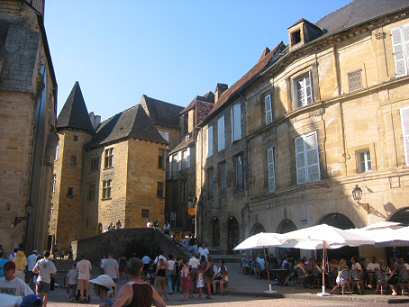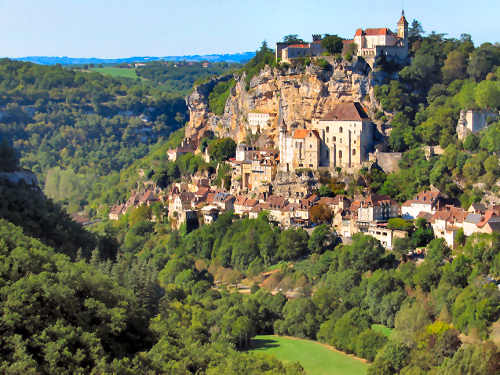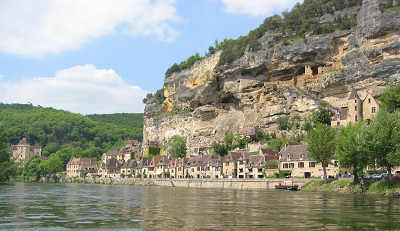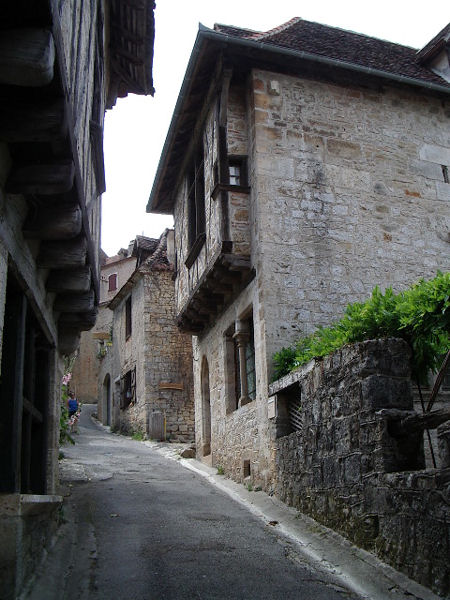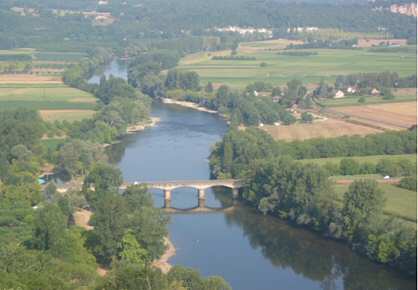 |
The Locality
The Dordogne also known as Périgord has a beautiful and varied landscape ranging from forested hills and valleys to dramatic river cliffs and rolling farmland. It is known for its chateâux and fortified churches, its pre-historic caves and the dozens of honey-coloured mediaeval villages that cover the area. The Dordogne valley has been awarded 3 stars in the Michelin Green Guide.
Beaulieu, in the hamlet of Les Cent Ecus is situated just outside Milhac, a pretty village, with its Romanesque church and chateau set on the top of a hill, giving views of the surrounding countryside. Beaulieu is approximately 8 miles from Gourdon, which is the capital of the green and undulating countryside called Le Bouriane. The town is set on a prominent hill, visible from several miles. There are numerous shops and restaurants on the main avenue and also along the lanes leading up to the top of the hill, where you will find a lovely view of the surrounding countryside from the remains of the château. Gourdon also has several supermarkets and a street market on most Tuesdays and every Saturday which should not be missed. (1 star in the Michelin Green Guide).
There are plenty of restaurants to choose from in the surrounding villages.
Nearby is the Grotte de Cougnac. These caves are fascinating for their natural rock formations and their paleolithic rock paintings of goat like animals, mammoths, extinct long horned deer and human figures. (1 star in the Michelin Green Guide).
We also have a château on our doorstep. Château de Fénelon, built on a hill overlooking the Dordogne and the Bouriane Forest, it dates back to the 15th century and its walls are triple fortified. Inside the courtyard there is a beautiful staircase with two bends, a chapel inside the Fénelon bedroom and a kitchen hollowed out of the rock. There is also a collection of mediaeval military miscellany.
|
|
Sarlat-La-Canéda (20 mins by car) is an unspoiled town with beautiful buildings and plenty of narrow alleys to explore. It has a mediaeval centre with many highlights including the Maison de la Boétie, Place de la Liberté (see above picture) Lanterne des Morts and a cathedral, parts of which date from the 12th century. On Saturdays the town buzzes with locals and visitors who have come for the lively street market. There is also a smaller market on Wednesday mornings. At night the narrow streets glow with gaslights as if from another era. There is a good choice of restaurants many of which spill out onto the cobbled streets. A visit to Sarlat is a must. (3 stars in the Michelin Green Guide)
|
|
Rocamadour
Rocamadour (30 mins by car) is the second most visited tourist attraction in France (after Mont St.Michel) and with good reason. It is a spectacularly situated pilgrimage centre clinging to the rock face of the Causse de Gramat, a deep picturesque gorge. Towering above the River Alzou on the cliff top is the 14th century château with ramparts. This can be reached either by a lift or via a steep stairway lined with the Stations of the Cross where you will find Place Saint Amadour with its seven churches. One of these, the Chapelle Notre Dame, has a statue of the Black Madonna renowned for the miracles she is believed to have performed and the 9th Century miraculous bell which rang of its own accord to foretell miracles. (3 stars in the Michelin Green Guide).
Domme (20 mins by car) is set on a steep promontory with breathtaking views across the Dordogne and Vézère valleys (2 stars in the Michelin Green Guide - the Panorama is awarded 3 stars). It is one of the few bastides to have retained most of its 13th century ramparts and three old town gates. The Porte des Tours, the most impressive and best preserved of these was used as a prison for the Knights Templar in the early 14th century and their graffiti can still be seen to this day. Underneath the village are the 'grottes'; 450m of stalactite-filled galleries whose entrance is in the covered market opposite the tourist office. Market day is on Thursday morning.
|
|
La Roque-Gageac
La Roque-Gageac (20 mins by car) is huddled against a cliff in a dramatic setting. It is an ancient riverside village with fascinating architecture, exotic gardens, caves and a troglodyte fort built into the cliff. Good base for exploring the river in a gabarre (the traditional river boat). La Roque Gageac has 2 stars in the Michelin Green Guide.
Situated nearby is the famous Château de Castelnaud a typical example of a mediaeval fortress that played an important part in the hundred years war. In the summer visitors can also visit the castle at night time and historical plays are performed in the torch-lit rooms. (2 stars in the Michelin Green Guide- the Panorama is awarded 3 stars)
Beynac-et-Cazenac (30 mins by car) is famous for its château which stands on a remarkable site rising from the top of a rock overlooking the beautiful Dordogne valley. You can drive up to the castle, but for those with a little more stamina, a steeply sloping footpath (Caminal del Panieraire) leads from the bottom of the village through the rows of houses (from the 15th and 17th centuries) with their gabled doorways and decorated facades to the château and the church (2 stars in the Michelin Green Guide).
Beynac and La Roque Gageac are two of the most beautiful villages of the region.
Jardins d'Eyrignac (20/25 mins by car) were laid out in the 18th century and are unique in the originality of their design. They are considered to be one of France's most beautiful gardens and have been awarded the Grand Prix des Jardins de France. In the 19th century the gardens were transformed into English gardens and it was the father of the present owner who decided to recreate and restore them to their original form. The work was started some 40 years ago. The gardens can be viewed at any time of year as they are mainly shrubs and trees but a newly created rosary has recently been added along with five fountains. (Well worth a visit -3 stars in the Michelin Green Guide).
|
|
Saint Cirq Lapopie
Saint Cirq Lapopie (1 hr by car) looks down onto the Lot river from its remarkable cliff top position 25km east of Cahors. It features many old houses which have been perfectly restored by artists and craftsmen who were attracted here by the beauty of the area. If you climb up to the château's ruins, on the edge of the village, you will get an awe inspiring view of Saint Cirq Lapopie and the Lot valley below. Although only small it is well worth a visit but can get quite crowded. (2 stars in the Michelin Green Guide)
Nearby is the Grotte du Pech Merle. Re-discovered in 1922, it has some of the best examples of pre-historic cave painting in the world. There is almost 1 mile of chambers and galleries to walk through with seven of the chambers decorated with some of the finest Palaeolithic drawings of animals and human figures that are still open to the public. As well as paintings it has carvings which are of great documentary value (3 stars in the Michelin Green Guide).
Cahors (45mins by car) the former capital of Quercy, is an excellent starting point for tours of the Célé and Lot valleys. Famous for its robust red wines, wine lovers can delight in tours of the vineyards but for those of you who prefer water to wine there are boat trips on the River Lot. If however you would rather keep your feet on dry land, take a walk down Boulevard Gambetta lined with plane trees, cafes and shops. Its busy bustling atmosphere reflects the fact that Cahors is an important commercial and administrative centre. Also why not visit the Cathedral, the mediaeval bridge (Le Pont Valentré) and the Barbican and Tour St-Jean (2 stars in the Michelin Green Guide).
Les Eyzies (45 mins by car) is the undisputed capital of prehistory. The area is an archaeological paradise with numerous ancient sites including caves, a 13th century fortress and a museum close to the town. The Musée National de la Préhistoire has some of the oldest art works in the world and provides very good background information about the area's prehistorice sites. Nearby are the caves of Moustier, Font de Gaume, Combarelles, La Madeleine and Laugerie-Basse amongst others. (2 stars in the Michelin Green Guide).
Souillac, approximately 11 miles away, has a charming old centre, with a bustling weekly market on Fridays, 11th-12th century abbey church and a fascinating museum of automata (the Musée de l’automate).
Bergerac (1 hr 20 mins). Bergerac is spread out on the banks of the Dordogne and a very pleasant place to visit. It is essentially an agricultural centre and is surrounded by vineyards, tobacco, cereal and maize. The old town and the harbour quarter which have retained some of the town's old time character are of particular interest. Take a boat trip down the river or have a coffee in one of the many cafes and restaurants. Well worth a visit before heading back to the Airport! (Old town - 2 stars in the Michelin Green Guide).
Food and Wine lovers
If you love food and wine then this is a wonderful place to visit. Périgord and Quercy are renowned as one of France's gourmet areas and are especially known for the fresh locally grown products that form the essence of their cuisine. Specialities include pâté de foie gras (goose liver pâté) which sometimes is flavoured with cognac and truffles.
Confit de canard is another speciality where the duck is cooked very slowly in its own fat. An expensive delicacy in this area is the truffle. The truffles of this region are black and rough in texture and are the most valued in French cuisine because of their distinctive aroma. Also this is the "route de noix" with walnuts being the main harvest. Visit the local markets and buy their walnut cakes or visit the walnut mill in Groléjac.
Wine is produced in Bergerac with equal harvests of red and white wines both dry and sweet. The best known red wine is the Cote de Bergerac and an excellent sweet vintage is Monbazillac, usually drunk with dessert. Another area famous for wine is Cahors where they have been producing wine since Roman times. Why not take the wine route which starts at Pont du Valentré in Cahors and follow it through the beautiful countryside and along the river?
Other places, things of interest:
The Dordogne River
If you want to get away from sightseeing then the Dordogne river (10 mins by car) is the ideal place to visit. It offers swimming, fishing, canoeing and boat rides. Why not hire a canoe or kayak for a few hours and float majestically down river only to be brought back to your car at the end of the day by mini bus?
The Périgord Quercy cycle path which is excellent for cycling, walking and roller blading is nearby and there are several stables in the locality for riding and trekking. If you are of a more adventurous spirit there is climbing and abseiling in Domme and hot air balloon rides within a short distance.
This is only a small selection of the many interesting sites and activities available in the area.
